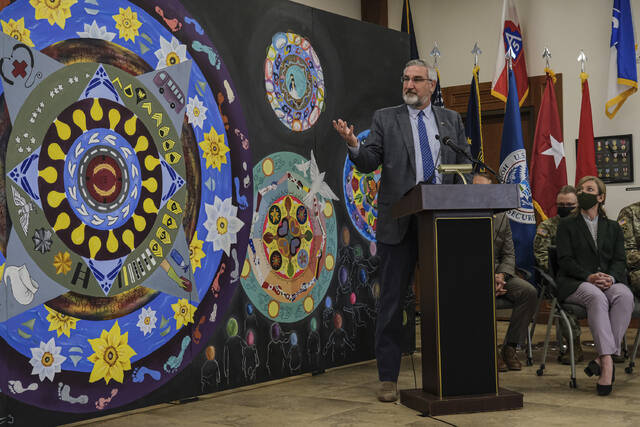
Mike Wolanin | The Republic Indiana Gov. Eric Holcomb speaks at a press conference at Camp Atterbury in Edinburgh, Ind., Monday, Jan. 24, 2022. Gov. Holcomb was joined by base officials and officials from the Department of Homeland Security to mark the conclusion of Operation Allies Welcome. Nearly all the Afghan refugees housed at Camp Atterbury have been resettled.
In vivid color, symbolic imagery and concentric circles, the experiences of nearly 60 Afghan refugees over the past five months came to life.
The 20-feet-long mural created by the refugees featured footprints that signified their flight as Taliban forces overran their homeland. At the center of the piece was a clock emblazoned with the number “15” — a reference to Aug. 15, the date when life fell apart in Afghanistan.
But elsewhere on the mural, lamp-like lights represented hope for the future. A band of daffodils, water and boats nodded at life’s new beginnings, rebirth and movement.
“It doesn’t take an artist’s eye, or art degrees, to instantly see and feel the beauty of this mural and what it symbolizes and reflects, knowing the hands and the souls and emotions that have poured out on this canvas,” Gov. Eric Holcomb said Monday morning.
Holcomb stood before the massive mural inside the Joint Visitors Bureau on Camp Atterbury, recognizing the struggles that Afghan refugees sent to the base have faced, and the next phase of their journey. His address represented the end of Atterbury’s participation in Operation Allies Welcome, the coordinated effort across the federal government to support and resettle vulnerable Afghans.
All but approximately 15 refugees have left Camp Atterbury, and those final few are expected to leave this week.
The federal portion of Operation Allies Welcome may be done in Indiana. But the state will continue to support those who have made the state their new home, Holcomb said.
“Our mission is accomplished here, but we will continue to walk side-by-side with our new residents here in the state of Indiana,” he said. “This was a true team effort.”
Operation Allies Welcome started in late August, a coordinated effort to welcome refugees into the country and prepare them for life in the United States. The work of processing and vetting those refugees has taken place at eight military bases throughout the country, including Atterbury.
Thus far, approximately 76,000 Afghan refugees have arrived in the United States since then, including 7,200 who have come to Atterbury, said Aaron Batt, Department of Homeland Security federal coordinator assigned to Atterbury. They’ve been provided shelter, food, medical care and resources as they’ve gone through the refugee resettlement process.
In recent months, Operation Allies Welcome winded down as refugees have been placed in their new homes. More than 63,000 refugees have been resettled across the country, including about 700 in Indiana, in cities such as Indianapolis, Bloomington, Muncie and South Bend. None have been placed in Johnson County, Batt said.
On Monday, Batt spoke to the gathered crowd to summarize the work that had been done to help those people. More than 69,000 vaccines against diseases such as measles, mumps and rubella had been administered to the refugees. More than 1.3 million meals were served, about 15,000 refugees took advantage of legal services and more than half took two or more life skills classes.
The outpouring of support for the refugees at Atterbury was overwhelming. About 2.6 million items, from money to clothing to furniture to anything else the refugees needed, flowed from the community.
“I just want to thank all of our Hoosiers, and anyone and everyone who made that possible,” Batt said. “There were of course several things that we as a federal government tried to provide, but the general public stepped in and provided most of those things.”
The event Monday also featured a number of officials involved in the operation, including Rep. Greg Pence, R-Ind., and Maj. Gen. R. Dale Lyles, the adjutant general for the Indiana National Guard who spoke of his own experience in Afghanistan and what it meant to help with this operation.
“I spent a little less than a year of my life in Afghanistan. There was a big part of me that was left in that country — we lost four of our soldiers, Indiana Hoosiers, while I was over there with my company. This goes a long way to healing some of those wounds,” Lyles said.
But the centerpiece of the press conference, both visually and emotionally, was the unveiling of the mural, titled “August. 15.” The mural was created by Tiffany Black, a visual artist from Indianapolis, and two refugee artists, Zainab Ahmadi and Fawzia Abdaly.
Black met the two women during her time at Camp Atterbury, teaching art through a program of the United States Conference of Catholic Bishops. They planned a painting that would bring other refugees together in a collaborative and healing process.
“Based on hundreds of therapeutic artworks created by our Afghan guests, Zainab, Fawzia and I complied these seven designs, which represent their collective thoughts, emotions, hopes and dreams,” Black said.
The painting is now set to be part of a traveling exhibition that will raise awareness, facilitate cultural connection and solicit donations for a children’s charitable organization in Afghanistan.
“By sharing this artwork and its stories, I hope to inspire Americans to welcome our Afghan friends into our communities,” Black said. “These men and women will work and live alongside us. Their children will grow up with our children.”




